
 The Jacobs-Ladder-O-Phone (of fire!)
The Jacobs-Ladder-O-Phone (of fire!)
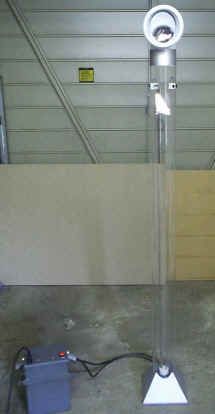
Click here for a video clip with sound (AVI, 1.3M) Click here for video close-up (AVI, 1.2M)
Some time ago, as many fans of things high-voltage do, I did some messing about with some small Jacob's Ladders. One of the things I found frustrating was that they were very susceptible to air currents, which tended to blow out the arc. I though that it might be better to use a clear tube to avoid this problem. However, lacking a suitable tube, I left the idea to slowly fester in the back of my ozone-addled mind.
Recently, a friend who seems to spend much of his time rummaging around in skips (dumpsters) gave me the remains of one of those decorative bubble-lamps. Recalling the immortal words of the great Ozzy Ozbourne "Bubbles? Bubbles? Come on, Sharon. I'm Ozzy Osbourne, the Prince of f#%ing Darkness. And I am not using f#*&ing bubbles." , I decided that this nice length of clear tube would be far better employed containing a nice sizzly high-voltage arc.
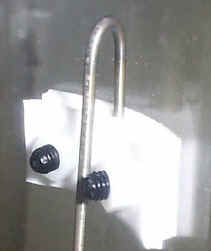
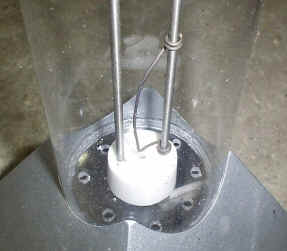 After some initial experiments with
spring-tensioned copper wire, I picked up a couple of stainless-steel antenna whips at a
radio rally (Hamfest), which made ideal electrodes - the stainless wouldn't corrode or
oxidise in the way that copper or steel rods would have. The base is a small block of
teflon, the tapered rods making a nice tight push-fit, and the rods were bent over at the
top (blowtorch required - stainless is VERY hard to bend cold, but is easy to work when
red-hot), and secured between two small pieces of teflon sheet, clamped together and
bolted to the side of the tube with M6 nylon screws. A small adjustable loop was placed at
the bottom to get it to start arcing and climb reliably. Power comes from a 10KV
60mA neon-sign transformer (NST). NSTs are perfect for jacob's ladders, as they are
internally current-limited.
After some initial experiments with
spring-tensioned copper wire, I picked up a couple of stainless-steel antenna whips at a
radio rally (Hamfest), which made ideal electrodes - the stainless wouldn't corrode or
oxidise in the way that copper or steel rods would have. The base is a small block of
teflon, the tapered rods making a nice tight push-fit, and the rods were bent over at the
top (blowtorch required - stainless is VERY hard to bend cold, but is easy to work when
red-hot), and secured between two small pieces of teflon sheet, clamped together and
bolted to the side of the tube with M6 nylon screws. A small adjustable loop was placed at
the bottom to get it to start arcing and climb reliably. Power comes from a 10KV
60mA neon-sign transformer (NST). NSTs are perfect for jacob's ladders, as they are
internally current-limited.
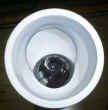
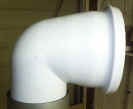 This setup worked nicely, but I felt it needed a little
"something extra".... One attractive feature of Jacob's Ladders is
the BZZZITTT noise they make. Confining the arc to a tube had an interesting
concentrating effect on this noise, but much of this went straight upwards. I found a
right-angled polypropylene pipe fitting, originally intented to connect the back of a
toilet to the sewer pipe (fortunately unused!), and made an ideal right-angled horn for
the top of the tube. This worked really well, directing the sound forwards, but then I had
another thought - what if there was a mirror inside, so you could look down on the arc. I
had a piece of silvered plastic sheet lying around from I can't remember what, and after
much cutting of cardboard mock-ups, finally got a shape that would fit nicely in the dual
diameters of the pipe fitting.
This setup worked nicely, but I felt it needed a little
"something extra".... One attractive feature of Jacob's Ladders is
the BZZZITTT noise they make. Confining the arc to a tube had an interesting
concentrating effect on this noise, but much of this went straight upwards. I found a
right-angled polypropylene pipe fitting, originally intented to connect the back of a
toilet to the sewer pipe (fortunately unused!), and made an ideal right-angled horn for
the top of the tube. This worked really well, directing the sound forwards, but then I had
another thought - what if there was a mirror inside, so you could look down on the arc. I
had a piece of silvered plastic sheet lying around from I can't remember what, and after
much cutting of cardboard mock-ups, finally got a shape that would fit nicely in the dual
diameters of the pipe fitting.
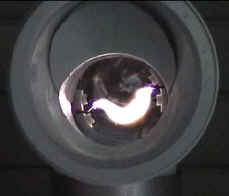
Of Fire....
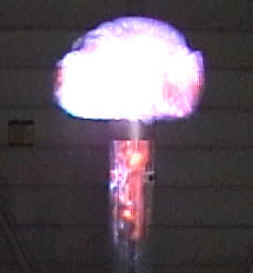
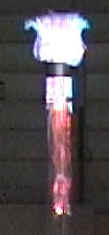
I did a brief experiment to see if anything interesting would happen if I
introduced a small amount of airflow from a compressed air nozzle, maybe making some sort
of vortex effect. This didn't work out, but in the process I thought it might be
interesting to see the air-currents created by the climbing arc. I remembered I had some
smoke-in-a-can which I used for laser experimentation, so tried spraying some of this into
the tube. Unfortunately, I didn't notice some of the small print on a little label on the
can (pictured right), and when the arc neared the top of the electrodes.... a loud
'Whoomf', a huge plume of flame, and a mildly scorched hand later, an idea was born....
Time to find a butane gas-lighter refill..... A quick squirt (WARNING : DO NOT USE TOO
MUCH!!!!), switch on... BZZZITTTWHOOOMFFFF! Cool!
Click here for a video clip with sound (AVI, 700K)


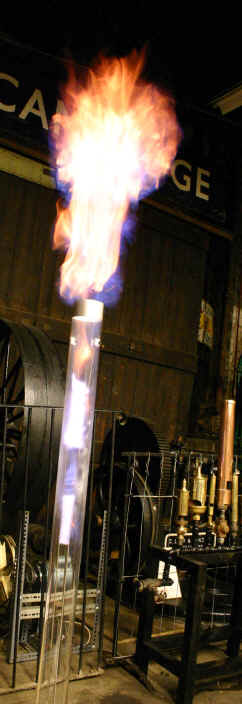
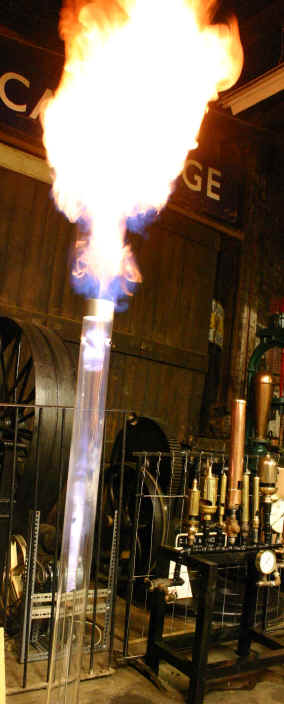
Hmmmmm.. now how about a system to automatically inject a small amount of butane into the top of the tube at the start of each arc....!!!
..with audio...
For a while I've wondered what a Jacob's Ladder would sound like if driven at frequencies other than mains...
I recently picked up the innards of a large PA amplifier at a redio rally (Hamfest) - from the size I estimate it was rated about 800-1000W when bridged. The output of this was fed into a big mains transformer to boost the output up to approximately mains voltage, and then into the Neon-Sign transformer.
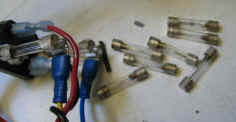 Results were quite encouraging - I tried feeding it from
both a signal generator and an audio source. The audio didn't work very well at all as the
'snap' of the spark dominated, but the sig-gen, sweeping from 50-200Hz was pretty
impressive, until the amplifier fuses blew. I managed a few runs with different
frequencies and sweep rates, but had to stop when I ran out of 15 Amp fuses..
Results were quite encouraging - I tried feeding it from
both a signal generator and an audio source. The audio didn't work very well at all as the
'snap' of the spark dominated, but the sig-gen, sweeping from 50-200Hz was pretty
impressive, until the amplifier fuses blew. I managed a few runs with different
frequencies and sweep rates, but had to stop when I ran out of 15 Amp fuses..
The Amplifier REALLY didn't like this treatment, the protection relay and clip LEDs coming on frequently. I think what is really needed is a really crude & brutal MOSFET squarewave driver switching directly into the transformer, maybe with a little risetime control to avoid too much ringing & voltage transients. - this will also be more efficient as switching losses will be much lower - watch this space....! Hmmmm - I wonder if a 3-phase motor inverter could be adapted to do this.....?
Here's a short AVI with sound (580K) with it running, using a 60-200Hz swept signal.
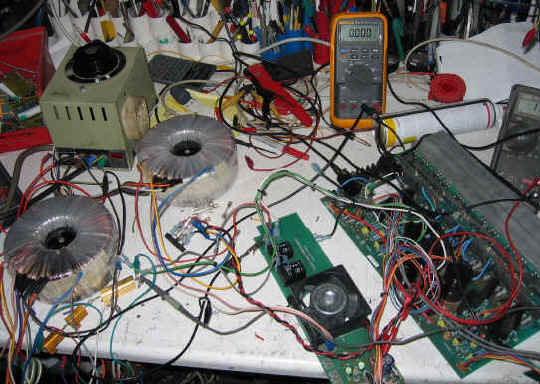 The test setup.... Two big 1KVA toroidal transformers -
one for the amplifier supply, the second to step the amp output up to mains voltage
The test setup.... Two big 1KVA toroidal transformers -
one for the amplifier supply, the second to step the amp output up to mains voltage